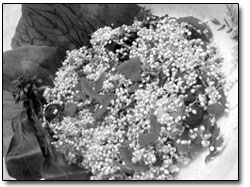| ||
In praise of the mother grain
by Chef Boy Ari All that’s left of the old palace is a wall of carved stones, joined expertly into a smooth surface that leans back slightly, away from the street. It’s 30 feet tall. On the other side of the street is a wall about half that size. Tucked into an arched doorway in the small wall, I saw an old man. It was dusk on the stone streets in Cuzco, Peru. With a silent gaze for a sales pitch, the old man was selling what looked like brown clay powder. I bought three sacks. That powder got me up and over 14,000-foot mountain passes, hiking the Inca trail toward Machu Picchu. Every morning, to help recover from the haze of oxygen-deprived dreams, I mixed quinoa flour with baking powder and powdered milk, or something like that, and made quinoa pancakes. The flavor was totally fulfilling, and my body hungered for the nutrients contained in those pulverized grains. Quinoa has been cultivated by the Indians of the high Andes for over 5,000 years. It was one of the main foods of the Inca, who called it chisaya mama, which means “Mother Grain.” It was, the geographer Alexander von Humboldt wrote, “what wine was to the Greeks, wheat to the Romans, cotton to the Arabs.” In Cuzco, the Incans worshipped entombed quinoa seeds as the progenitors of the city. Quinoa grows best in cold, high, dry conditions. Some varieties can even tolerate saline soils. Often lumped, incorrectly, with grains like rice or wheat, Quinoa is in the goosefoot family. Its many edible relatives include lamb’s quarter and plantain, and as with those well-known edible weeds, quinoa leaves are edible too. The seeds, meanwhile, contain more protein than any grain, along with a full balance of amino acids – including the elusive lysine. There are hundreds of quinoa varieties; seeds run the spectrum from red to orange to purple to black. While most of the world’s quinoa comes from the Andean nations – especially Bolivia and Peru – organic farmers in Colorado’s high San Luis Valley are growing it too. Choosing between local, organic quinoa and its counterpart from the motherland of the mother grain – grown by real Quechua Indians and shipped halfway around the world with real fossil fuels – is a riddle of values, like choosing between paper and plastic at the supermarket checkout line. I decided to ponder this riddle over a bowl of sprouted quinoa tabouli, a Middle Eastern salad normally made with a cracked wheat or bulgur. Substituting sprouted quinoa in the tabouli creates something of a Middle East-meets-South American fusion, with ancient roots and a New Age finish. Totally cosmic, in other words. Totally delicious, too. It fills you up with flavor, but doesn’t leave you feeling heavy. You should always rinse quinoa seeds to remove traces of the bitter husk, or saponin, which is removed after harvest. To sprout quinoa, soak the rinsed seeds in water for two to four hours. Then drain, rinse, drain again and put the quinoa in a jar, covered by a screen or mesh, and invert the jar at a 45-degree angle so excess moisture can drain. Repeat this procedure daily until they sprout, in two or three days. On the last day, put the sprouts in the window to green up. If you don’t have the time or inclination to make sprouts, you can make the same salad with cooked quinoa. Just add a cup of rinsed quinoa to 2 cups water and a pinch of salt. Bring to a boil and simmer for about 15 minutes, until the water is absorbed and the germ begins to stand out against the grain, looking like a tail wrapped around a translucent ball. In a bowl, mix chopped parsley and cilantro, sliced olives, sliced cucumber, diced tomato, 3 tablespoons lemon juice, 2 tablespoons olive oil and soy sauce to taste. Add the quinoa and toss. If you can’t get fresh tomatoes, pickled sweet peppers make a good substitute. A little feta on top is nice. I’d give you the quinoa flour pancake recipe too, but like my recollection of the face of the old man who sold me the flour, that memory is long gone. It’s too bad, because he is the one I would buy my quinoa from if I could, and therein lies the answer to the riddle. Go for the best quality quinoa, directly from the farmer if you can find it. For some of Colorado’s finest, try whitemountainfarm.com. The merchant also sells quinoa flour. Meanwhile, some sprouts will escape my tabouli and make it to the soil. I’m planting them now, kind of late, so they won’t try to flower during the 90-degree heat of summer, which would thwart the blossoms. At the very least I’ll get some greens out of the deal – maybe lots of them. Based on how its relatives perform in my garden, quinoa should grow like a weed. •
|
In this week's issue...
- May 15, 2025
- End of the trail
Despite tariff pause, Colorado bike company can’t hang on through supply chain chaos
- May 8, 2025
- Shared pain
Dismal trend highlights need to cut usage in Upper Basin, too
- April 24, 2025
- A tale of two bills
Nuclear gets all the hype, but optimizing infrastructure will have bigger impact


